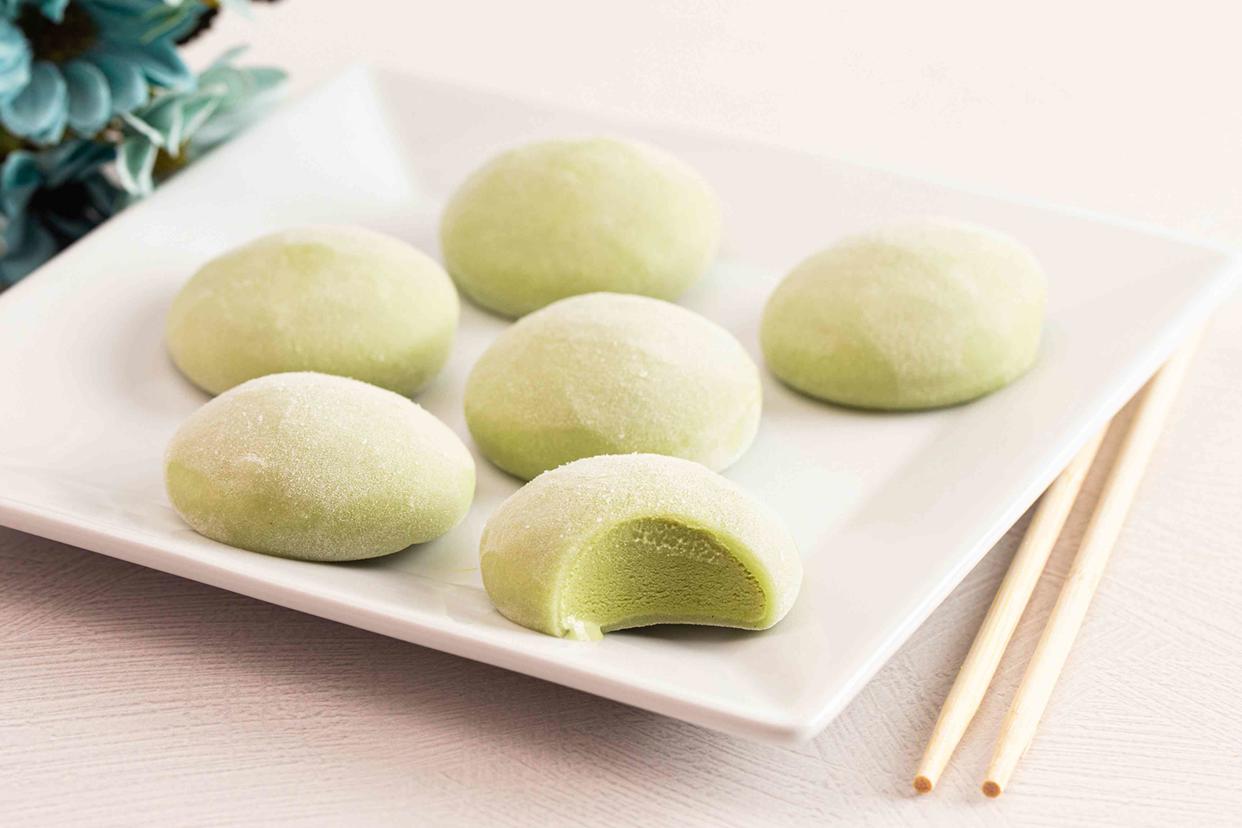There's More to Mochi Than Ice Cream—Here's Why You're Seeing the Japanese Food Everywhere
Move over, macarons. Mochi, another colorful mouthful, is taking its turn in the dessert spotlight.

Getty Images
Mochi may not be a household word stateside, but this signature Japanese treat is certainly picking up steam, winning millions of views on TikTok and filling the pages of cookbooks. Ice cream interpretations abound in the frozen food section of grocery stores, Japanese bakeries offer creative takes, and food and beverage trend reports have pegged it as a dessert to watch, all sowing the seeds of interest. While, you may be vaguely familiar with this treat that's popular throughout East Asia, we have a hunch it's only a matter of time before you become better acquainted with mochi's many modes. Here's what you need to know about mochi, from its symbolism to its many variations.
Meet Our Expert
Danny Taing, owner and founder of Bokksu, a snack box subscription service specializing in artisanal Japanese products
Sabrina Fauda-Rôle, food stylist and author of Mochi: Make Your Own at Home
Related: Macaroons and Macarons Are Not the Same—Learn the Difference Between These Popular Cookies
What Is Mochi?
Mochi is known for being available in a rainbow array of colors, but its texture, size, and ingredients are equally distinctive.
What Is Mochi Made Of?
“Mochi is a Japanese rice cake made from sweet glutinous rice, and it is naturally gluten-free," explains Danny Taing, owner and founder of Bokksu, a snack box subscription service specializing in artisanal Japanese products (including mochi) and an online Asian market offering pantry essentials.
How mochi is made: "Traditionally, it is made by steaming the glutinous rice, then pounding it until it reaches a soft and chewy consistency," says Taing. The mochi-making process, called mochitsuki, entails using a wooden mallet to aerate and pulverize the rice, transforming it into a soft dough.
Characteristics: The texture of this dumpling-sized marvel is elastic, with a slightly gooey side, says Sabrina Fauda-Rôle, a France-based food stylist and author of Mochi: Make Your Own at Home. "It's often shaped like a small pillow and can be filled with sweet or savory preparations."
Visual sensation: The color story also informs mochi's taste. Mochi are traditionally colored with natural dyes such as green tea, and their color often indicates their flavor, says Fauda-Rôle.
Why Mochi, Why Now?
Mochi's beginnings date back to the prehistoric Jomon period when Japan's rice cultivation proliferated, but it wasn't until the Nara period (710-794 CE) that it took on today's characteristics. By the Heian period (794-1185 CE), royals in the Imperior court were smitten, and by the Edo period (1603-1868), mochi became established as a bona-fide Japanese treat and regional iterations flourished.
Mochi's burgeoning popularity in Western countries can be attributed to several factors, including a growing interest in diverse cultures and unique culinary experiences. Its natural ingredients, including fruit and bean pastes, also score points with health-conscious food fans, as does its gluten-free status.
Mochi's Many Variations
Filled, stacked, or matched with frozen desserts, mochi is super versatile.
Ice Cream Mochi
For many people, mochi means ice cream mochi. Individual snack-size desserts in flavors like mango, chocolate, matcha, and black sesame are often the entry point of mochi discovery. The mochi dough encases a small scoop of ice cream, but ice cream mochi are just the beginning; the mochi landscape is filled with infinite varieties.
Sweet or Savory
Mochi ranges from sweet to savory, from classic to unconventional. Many types are served with green tea, or as part of intricate desserts, or hot pot dishes. Different regions of Japan are home to unique mochi specialties. Mochi, explains Taing, is more than a delicious mouthful. Woven into the cultural fabric for centuries, some are associated with the seasons or special holidays. “In Japan, it's also recognized as a treat that brings good luck and is a big part of many celebrations at various festivals and ceremonies, like the New Year," he says.
Daifuku Mochi
Daifuku (or stuffed mochi) is usually eaten during Japanese New Year celebrations. It's also part of tea ceremonies, called chado, and spring festivals. This confection is traditionally filled with anko, a sweet red bean paste, and sometimes with a whole fresh fruit like a strawberry (called ichigo daifuku). "There are no limitations on the kinds of filling. Other popular flavors include matcha, strawberry, yuzu, and more," says Taing.
Daifuku, Fauda-Rôle notes, is the mochi that first got her hooked. "When I discovered daifuku mochi, I immediately fell in love with them, and the idea of making them at home came to me so that I could enjoy them more often without having to go to the store every time and makes it more budget-friendly," she explains.
Classic and Beyond
In addition to daifuku, other popular types include:
Bota mochi: Also called ohagi, this mochi resembles an inside-out daifuku, with the rice dough inside and the sticky filling, red bean paste, on the outside.
Kuri mochi: This sweet chestnut mochi unites chocolate, white bean paste, and chopped chestnuts.
Kusa mochi: Also called yomogi mochi, this variety is flavored with kusa, a wild grass (also referred to as mugwort), with a grassy taste reminiscent of green tea.
Kuzu mochi: Soft and jelly-ish with a nutty flavor, this mochi, also called kuzuko, is traditionally paired with kinako, soybean powder, and kuromitsu, or brown sugar.
Sakura mochi: Pink, sweet, and sometimes wrapped in a salty sakura blossom leaf, this springtime mochi is a cherry blossom season favorite.
Hishi mochi: A three-layer mochi symbolic of fertility, this rhombus-shaped variation is part of Girl's Day festivals, celebrating the health and happiness of young girls.
Warabimochi: A summertime snack, this jelly-like, translucent mochi, made from bracken powder, tastes somewhat like unflavored tapioca pearls. It's served the same way as kuzu mochi.
Yaki mochi: A wintertime bite, this mochi is toasted over hot coals till soft and gooey.
Read the original article on Martha Stewart.






